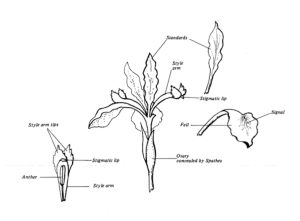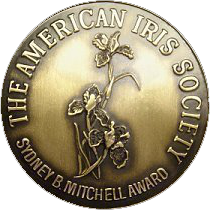Hybridizing Pacificas
Introduction
Although modern hybrids may be generations away from the native species, the parentage of Pacifica (PCI) hybrids can be traced back to the twelve iris species native to the West Coast of North America of the series Californicae.
By crossing selected parents, hybridizers over the past century have developed many gorgeous flower colors and patterns in this group. However outside of flower color and pattern, the heart of hybridizing efforts has been on developing plants that grow more readily in a garden setting. Part artist, part craftsman, hybridizers select for desirable traits like vigor, heat and cold tolerance, flower size and color, attractive foliage, bud count, and bloom time to meet garden needs.
How to Make Crosses

All iris flowers have three sets of petal-like structures. The largest and lowest set is the falls; the falls fold out and down, and are often the most brilliantly colored parts of the flower.
The upper set of petals is the standards; these are upright to spreading, seen from the side, and alternate with the style arms when the flower is viewed from above.
The next set is the style arms; these are smaller, and have a small lip (the stigmatic surface or crest) on the underside, also called the style. There are small projections, called the style crests or tips, visible on the outer ends of the style arms.
The stigma or stigmatic surface is a small lip on the underside of each style arm. Pollen attaches to the stigma, then pollen tubes grow down the style arm to each ovule in the ovary. The stigma is slightly sticky when receptive to pollen.
Pollen forms in anthers. Anthers hug the undersides of the style arms. In nature, bees wiggle under the anthers to reach the nectar at the base of the flower and their bodies pick up pollen. When they wiggle into the next flower, pollen is scraped off on the stigmatic surface of the style lip. Acting as bees, gardeners mimic this by collecting pollen and putting it on specific flowers.
If the day is dry, and the pollen is ready, you can remove the anther and gently rub it over the stigma. It is easy to bruise the stigma and thereby damage it, so be very gentle. If it is damaged, the pollen tube cannot grow down the style arm to the ovary.
Alternatively, pollen can also be held in a dry container. Using a small paintbrush, pick up pollen on a clean brush and gently dab it on the stigmatic surface. When ripe, pollen is yellow and easily rubs off the anthers when they are gently rubbed between fingers.
Falls can be removed so bees cannot pollinate those flowers after you have applied your selected pollen to the stigma. The stigma is most receptive a few hours after the flower first opens. A day or two later, the pollen ripens in the anthers. This way, most iris flowers reduce the amount of self-crossing or selfing, which is when pollen from a flower fertilizes the ovaries of that same flower, or other flowers on the same plant by insects moving the pollen around.
After pollination, the petals will dry and drop off, leaving the ovary, the slightly swollen area on the stem beneath each flower. This is often hidden behind the spathes or bracts. If pollination is successful the ovary will swell and form a pod as seeds ripen.
Remember to label that flower stem, indicating the date, the pollen parent and the pod parent, or the crossing code.
There are two kinds of deliberate crosses to make:
- Self-crossing or selfing, where pollen from the pod parent or one of its clones is used on its flowers.
- Out-crossing, where pollen from a different plant is used.
Bee pollinated flowers, on the other hand, produce open or out crossed seeds and the pollen parent is unknown.
If you are going to do your own hybridizing, it’s helpful to other hybridizers that you know both parents.
Judging PCI hybrids
For gardeners who do their own hybridizing, as new seedlings begin to flower it will become clear that not all seedlings are alike. But how to evaluate them and decide which ones are worth keeping, and which ones should be tossed?
Welcome to the world of judging species selections and hybrids.
In the iris world, good new hybrids have healthy plant form, or distinctive new form, or distinctly new flower characters, with clear colors and pleasing patterns. Judging (and selecting) is the way hybridizers develop new hybrids that are healthy, well proportioned and significant in plant form, habit, foliage, flowering stems and flowers, using national standards.
It often takes several years to evaluate a new plant, especially if you are breeding for cold or heat resistance, or early or late flowering characteristics. Visit several gardens that display the same new plants to see how these plants respond to different growing conditions and microclimates.
Evaluations are always done in gardens, not on potted plants nor on wild populations. A plant that does well in one garden or year might not in another; performance in several locations over a few years is important.
PCI judging standards are codified in the AIS Judge’s Handbook, which includes standards for all sections of the genus Iris. This serves as an important guide to ensure quality plants are introduced to the public.
As a quick overview, plants should be healthy, vigorous and hardy. Foliage should clump attractively. Stalks should be held gracefully upright. There is no best stalk height or flower form, color or pattern prescribed, but all parts of the plant should be pleasing and in good proportion to each other.
For those considering introducing new PCIs, please review the chapter on Pacific Coast Irises in the AIS Judge’s handbook for a more in-depth guide. If you’re curious to learn more, reach out to your local AIS chapter where training and classes are held on how to judge and evaluate plants.
More detailed criteria and information can be found in AIS Judge’s Handbook chapter on Pacific Coast Native Iris.
The Mitchell Medal

The Mitchell Medal recognizes success as the year’s single best new variety of Pacific Coast Native Iris each year. It is the highest award for excellence given by the American Iris Society to a Pacifica iris.
A PCI must first receive an Honorable Mention and an Award of Merit from the judges before qualifying for the Mitchell Medal. Each candidate has been viewed for a minimum of 8 years by AIS judges.
Sydney B. Mitchell was the first president of the California Horticultural Society, an author of several gardening books, and one of the earliest to urge the use of native plants in home gardens.
For more information on the Sydney B. Mitchell Medal can be found on our Mitchell Award page as well as the AIS website.
References
Hubley, Robert P., Ghio, Joe, 1981. Planned parenthood, Pacific Coast Native style, SPCNI Almanac, Fall 1981, p 8.
Hujsak, Dorothy and Witt, Jean. 1981. Questions and Answers (on pollination), SPCNI Almanac, Fall 1981, p 9, with an illustration by Jean Witt of iris flower parts.
Lawyer, Lewis. 1988. Expanding our territory, a project open to every member, SPCNI Almanac, Spring 1988, pp 8-23.
